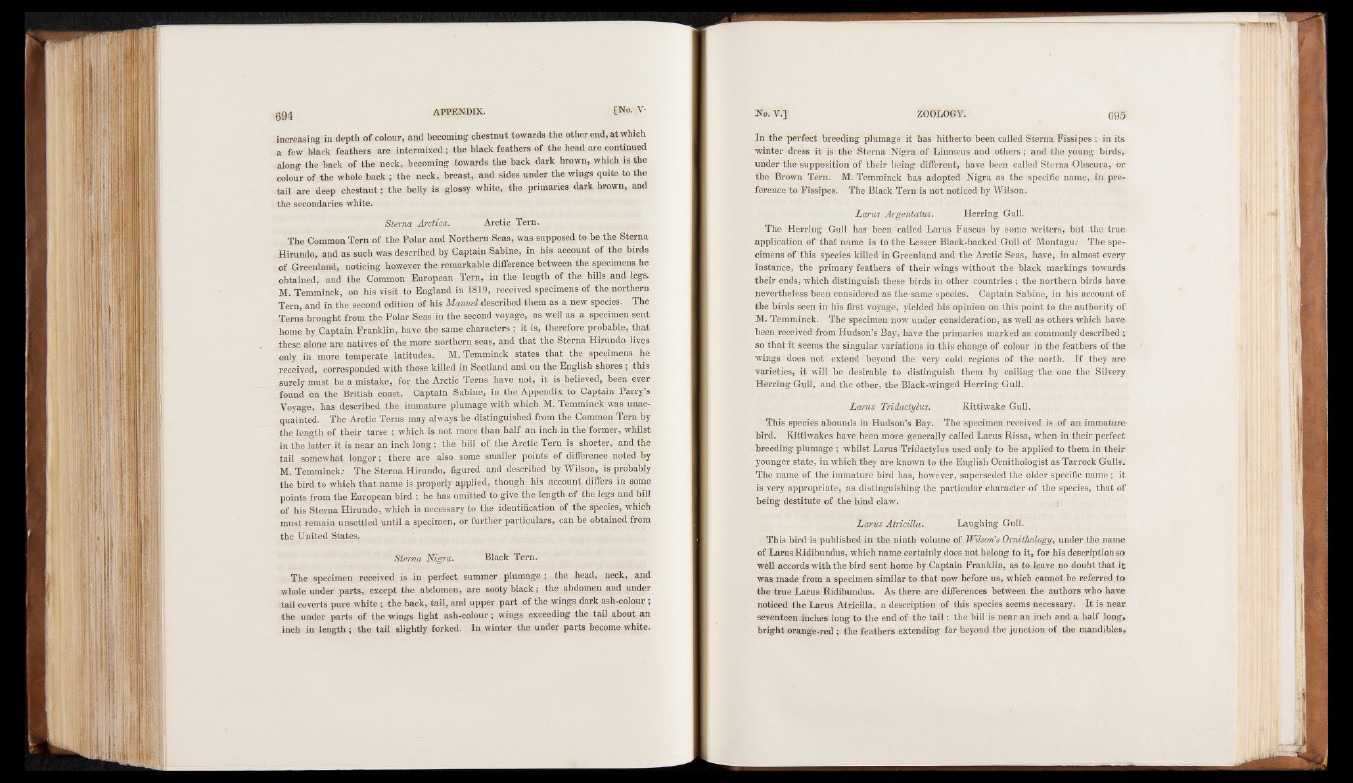
increasing in depth of colour, and becoming chestnut towards the other end, at which
a few black feathers are intermixed; the black feathers of the head are continued
along the back of the neck, becoming towards the back dark brown, which is the
colour of the whole back ; the neck, breast, and sides under the wings quite to the
tail are deep chestnut; the belly is glossy white, the primaries dark brown, and
the secondaries white.
Sterna Arctica, Arctic Tern.
The Common Tern of the Polar and Northern Seas, was supposed to be the Sterna
Hirundo, and as such was described by Captain Sabine, in his account of the birds
of Greenland, noticing however the remarkable difference between the specimens he
obtained, and the Common European Tern, in the length of the bills and legs.
M. Temminck, on his visit to England in 1819, received specimens of the northern
Tern, and in the second edition of his Manuel described them as a new species. The
Terns brought from the Polar Seas in the second voyage, as well as a specimen sent
home by Captain Franklin, have the same characters ; it is, therefore probable, that
these alone are natives of the more northern seas, and that the Sterna Hirundo lives
only in more temperate latitudes. M. Temminck states that the specimens he
received, corresponded with those killed in Scotland and on the English shores; this
surely must be a mistake, for the Arctic Terns have not, it is believed, been ever
found on the British coast. Captain Sabine, in the Appendix to Captain Parry’s
Voyage, has described the immature plumage with which M. Temminck was unacquainted.
The Arctic Terns may always be distinguished from the Common Tern by
the length of their tarse ; which is not more than half an inch in the former, whilst
in the latter it is near an inch long; the bill of the Arctic Tern is shorter, and the
tail somewhat longer; there are also some smaller points of difference noted by
M. Temminck; The Sterna Hirundo, figured and described by Wilson, is probably
the bird to which that name is properly applied, though his account differs in some
points from the European bird ; he has omitted to give the length of the legs and bill
of his Sterna Hirundo, which is necessary to the identification of the species, which
must remain unsettled until a specimen, or further particulars, can be obtained from
the United States.
Sterna Nigra. Black Tern.
The specimen received is in perfect summer plumage ; the head, neck, and
whole under parts, except the abdomen, are sooty black; the abdomen and under
tail coverts pure white ; the back, tail, and upper part of the wings dark ash-colour ;
the under parts of the wings light ash-colour; wings exceeding the tail about an
inch in length; the tail slightly forked. In winter the under parts become white.
In the perfect breeding plumage it has hitherto been called Sterna Fissipes ; in its
winter dress it is the Sterna Nigra of Linnæus and others ; and the young birds,
under the supposition of their being different, have been called Sterna Obscura, or
the Brown Tern. M. Temminck has adopted Nigra as the specific name, in preference
to Fissipes. The Black Tern is not noticed by Wilson.
Larus Argentatus. Herring Gull.
The Herring Gull has been called Larus Fuscus by some writers, but the true
application of that name is to the Lesser Black-backed Gull of Montagu; The specimens
of this species killed in Greenland and the Arctic Seas, have, in almost every
instance, the primary feathers of their wings without the black markings towards
their ends, which distinguish these birds in other countries ; the northern birds have
nevertheless been considered as the same species. Captain Sabine, in his account of
the birds seen in his first voyage, yielded his opinion on this point to the authority of
M. Temminck. The specimen now under consideration, as well as others which have
been recèived from Hudson’s Bay, have the primaries marked as commonly described ;
so that it seems the singular variations in this changé of colour in the feathers of the
wings does not extend beyond the very cold regions of the north. If they are
varieties, it will be desirable to distinguish them by calling the one the Silvery
Herring Gull, and the other, the Black-winged Herring Gull.
Larus Tridactylus. Kittiwake Gull.
This species abounds in Hudson’s Bay. The specimen received is of an immature
bird. Kittiwakes have been more generally called Larus Rissa, when in their perfect
breeding plumage ; whilst Larus Tridactylus used only to be applied to them in their
younger state, in which they are known to the English Ornithologist as Tarrock Gulls.
The name of the immature bird has, however, superseded the older specific name ; it
is very appropriate, as distinguishing the particular character of the species, that of
being destitute of the hind claw.
Larus AtriciUa. Laughing Gull.
This bird is published in the ninth volume of Wilson's Ornithology, under the name
of Larus Ridibundus, which name certainly does not belong to it, for his description so
well accords with the bird sent home by Captain Franklin, as to leave no doubt that it
was made from a specimen similar to that now before us, which cannot be referred to
the true Larus Ridibundus. As there are differences between the authors who have
noticed the Larus Atricilla, a description of this species seems necessary. It is near
seventeen inches long to the end of the tail ; the bill is near an inch and a half long,
bright orange-red ; the fèathers extending far beyond the junction of the mandibles,